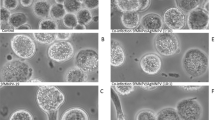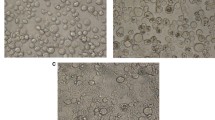Abstract
The baculovirus Anticarsia gemmatalis nucleopolyhedrovirus (AgMNPV), a member of the family Baculoviridae, has been widely applied as a biopesticide for the control of the velvetbean caterpillar, a pest of soybean crop field. Baculoviruses are considered safe and efficient agents for this purpose, because they do not infect vertebrates, being safe for the health of humans and animals, as well as to the environment. The objective of this work was to identify proteins obtained from Lonomia obliqua hemolymph with potential application in the optimization of baculovirus AgMNPV replication in Sf9 insect cell culture. In this work the improvement of the cell culture and viral replication of the AgMNPV baculovirus was observed when Grace medium was supplemented with 10 % (v/v) Fetal Bovine Serum (FBS), 1 % (v/v) hemolymph extract, or 3 % (v/v) of hemolymph fractions or hemolymph sub-fractions obtained by purifying hemolymph through High Performance Liquid Chromatography. Hemolymph presented a positive effect on the synthesis of polyhedra and enhanced baculovirus replication in Spodoptera frugiperda (Sf9) cells (TCID50/mL), and led to Sf9 cell culture improvement. Grace medium supplemented with 10 % (v/v) FBS and 1 % (v/v) hemolymph provided an increase of baculovirus replication, when the cells were infected with multiplicity of infection of 1. In this case, the baculovirus replication was 6,443.91 times greater than that obtained with the control: Grace medium supplemented with 10 % (v/v) FBS. In addition, this work suggests that hemolymph from L. obliqua could have an interesting application in biotechnology, due to an increase in the viability of the cells and virus replication.







Similar content being viewed by others
References
Batista FRX, Pereira CA, Mendonça RZ, Moraes AM (2005) Enhancement of Sf9 cells and baculovirus production employing Grace’s medium supplemented with milk whey ultrafiltrate. Cytotechnology 49:1–9
Batista FRX, Pereira CA, Mendonça RZ, Moraes AM (2006) Evaluation of concentrated milk whey as a supplement for Sf9 Spodoptera frugiperda cells in culture. Electron JBiotechnol 9:522–532
Choi SS, Rhee WJ, Park TH (2002) Inhibition of human cells apoptosis by silkworm hemolymph. Biotechnol Prog 18:874–878
Guerrero B, Perales J, Gil A, Arocha-Pinango CL (1990) Effect on platelet FXIII and partial characterization of Lonomin V, a proteolytic enzyme from Lonomia achelous caterpillars. Thromb Res 5:243–252
Hamdaoui A, Wataleb S, Devreese B, Chiou SJ, Vanden Broeck J, Van Beeumen J, De Loof A, Schoofs L (1998) Purification and characterization of a group of five novel peptide serine protease inhibitors from ovaries of the desert locust, Schistocerca gregaria. FEBS Lett 422:74–78
Harris DC (2001) Análise química quantitativa, 5a edn. Editora LTC, Rio de Janeiro
Jiang H, Wang Y, Kanost MR (1999) Four serine proteinases expressed in Manduca sexta haemocytes. Insect Mol Biol 8:39–53
Kanaya T, Kobayashi J (2000) Purification and characterization of an insect hemolymph protein promoting in vitro replication of the Bombyx mori nucleopolyhedrovirus. J Gen Virol 81:1135–1141
Kim EJ, Rhee WJ, Park TH (2001) Isolation and characterization of an apoptosis-inhibiting component from the hemolymph of Bombyx mori. Biochem Biophys Res Commum 285:224–228
Kim EJ et al (2003) Inhibition of apoptosis by recombinant 30 K protein originating from silkworm hemolymph. Biochem Biophys Res Commum 308:523–528
Kurata K, Nakamura M, Okuda T, Hirano H, Shinbo H (1994) Purification and characterization of a juvenile hormone binding protein from hemolymph of the silkworm, Bombyx mori. Comp Biochem Physiol Biochem Mol Biol 109:105–114
Lee SH, Park TH (1994) Growth limiting factors influencing high density culture of insect cells in Grace´s medium. Biotechnol Lett 16:327–332
Lin CY, Chen SH, Kou GH, Kuo CM (1998) Identification and characterization of a hyperglycemic hormone from freshwater giant prawn, Macrobrachium rosenbergii. Comp Biochem Physiol A: Mol Integr Physiol 121:315–321
Lowry OH, Rosebrough NJ, Farr AL, Randall RJ (1951) Protein measurement with the Folin phenol reagent. J Biol Chem 193:265–275
Maranga L, Mendonça RZ, Bengala A, Peixoto CC, Moraes RHP, Pereira CA, Carrondo MJT (2003) Enhancement of Sf9 cells growth and longevity through supplementation of culture medium with hemolymph. Biotechnol Prog 19:58–63
Moon HJ, Kurata S, Natori S, Lee BL (1995) Purification and cDNA cloning of an antifungal protein from the hemolymph of Holotrichia diomphalia larvae. Biol Pharm Bull 18:1049–1052
Ochanda JO, Osir EO, Nguu EK, Olembo NK (1992) Isolation and properties of 600-kDa and 23-kDa hemolymph proteins from the tsetse fly, Glossina morsitans: their possible role as biological insecticides. Scand J Immunol Suppl 11:41–47
Peters ID, Rancourt DE, Davies PL, Walker VK (1993) Isolation and characterization of an antifreeze protein precursor from transgenic Drosophila: evidence for partial processing. Biochim Biophys Acta 1171:247–254
Rhee LJ, Munch H (1938) A simple method of estimating fifty per cent end points. Am J Hyg 27:493–497
Rhee WJ, Park TH (2000) Silkworm hemolymph inhibits baculovirus-induced insect cell apoptosis. Biochem Biophys Res Commun 271:186–190
Rodas VM, Marques FH, Honda MT, Soares DM, Jorge SAC, Antoniazzi MM, Medugno C, Castro MEB, Ribeiro BM, Souza ML, Tonso A, Pereira CA (2005) Cell culture derived AgMNPV bioinsecticide: biological constraints and bioprocess issues. Cytotechnology 48:27–39
Rosenfeld A, Vanderberg JP (1998) Identification of electrophoretically separated proteases from midgut and hemolymph of adult Anopheles stephensi mosquitoes. J Parasitol 84:361–365
Shiotsuki T, Bonning BC, Hirai M, Kikuchi K, Hammock BD (2000) Characterization and affinity purification of juvenile hormone esterase from Bombyx mori. Biosci Biotechnol Biochem 64:1681–1687
Shishikura F, Abe T, Ohtake S, Tanaka K (1997) Purification and characterization of a 39,000-Da serine proteinase from the hemolymph of a solitary ascidian, Halocynthia roretzi. Comp Biochem Physiol B: Biochem Mol Biol 118:131–141
Souza APB, Peixoto CC, Maranga L, Carvalhal AV, Moraes RHP, Mendonça RMZ, Pereira CA, Carrondo MJT, Mendonça RZ (2005) Purification and characterization of an anti-apoptotic protein isolated from Lonomia obliqua hemolymph. Biotechnol Prog 21:99–105
Vaughn JL, Weiss SA (1990) Large-scale propagation of insect cells. Bioprocess Technol 10:597–618
Wang MY, Kmong S, Bentley WE (1993) Effects of oxygen/glucose/glutamine feeding on insect cells baculovirus protein expression: a study on epoxide hydrolase production. Biotechnol Prog 9:355–361
Woo SD, Kim WJ, Kim HS, Choi JY, Jin BR, Kang SK (1997) Effect of silkworm hemolymph on the expression of E. coli beta-galactosidase in insect cells lines infected with recombinant baculoviruses. Mol Cells 31:572–574
Yamamoto Y, Watabe S, Kageyama T, Takahashi SY (1999) Purification and characterization of cysteine proteinase specific inhibitors from the hemolymph of Bombyx mori. Arch Insect Biochem Physiol 42:119–129
Zhu S, Li W, Jiang D, Zeng X (2000) Evidence for the existence of insect defensin-like peptide in scorpion venom. IUBMB Life 50:57–61
Acknowledgments
The authors are grateful and appreciated financial support from Coordenação de Aperfeiçoamento de Pessoal de Nível Superior (CAPES, Brasília, Brazil), Fundação de Amparo à Pesquisa do Estado de São Paulo (FAPESP), and Butantan Foundation (São Paulo, Brazil).
Author information
Authors and Affiliations
Corresponding author
Rights and permissions
About this article
Cite this article
Sousa, Á.P.B., Moraes, R.H.P. & Mendonça, R.Z. Improved replication of the baculovirus Anticarsia gemmatalis nucleopolyhedrovirus (AgMNPV) in vitro using proteins from Lonomia obliqua hemolymph. Cytotechnology 67, 331–342 (2015). https://doi.org/10.1007/s10616-014-9689-0
Received:
Accepted:
Published:
Issue Date:
DOI: https://doi.org/10.1007/s10616-014-9689-0




